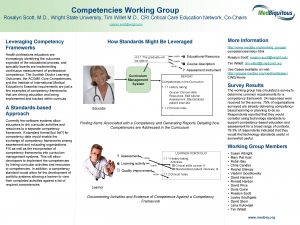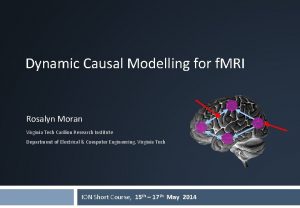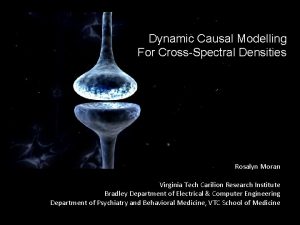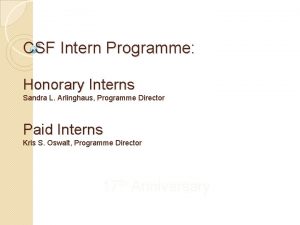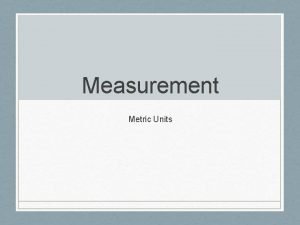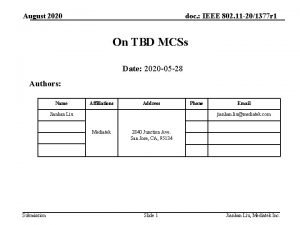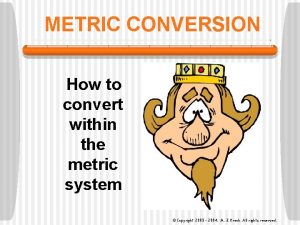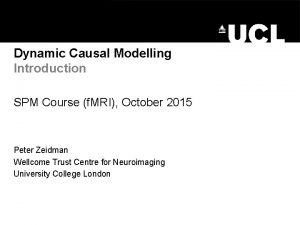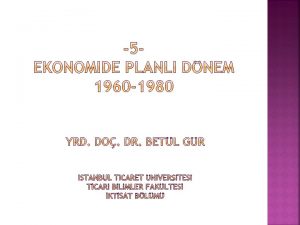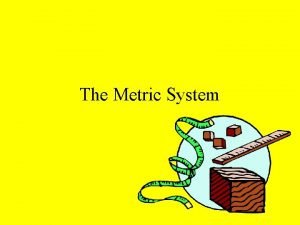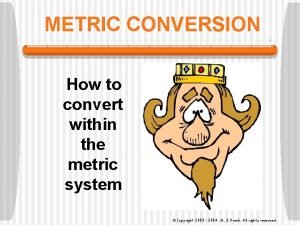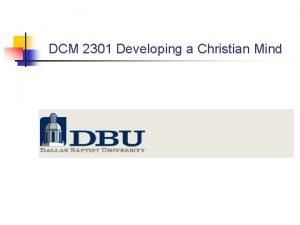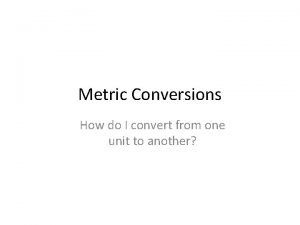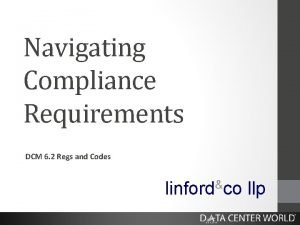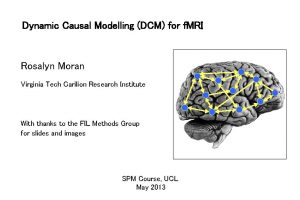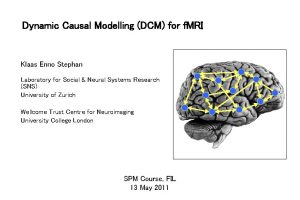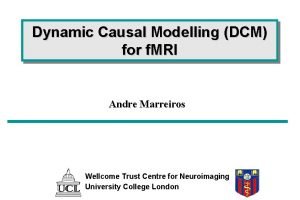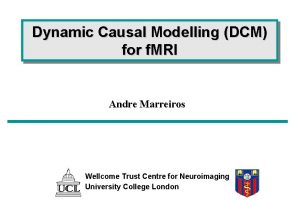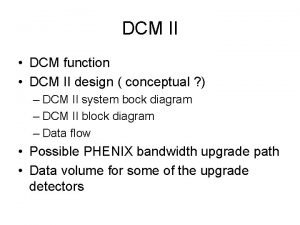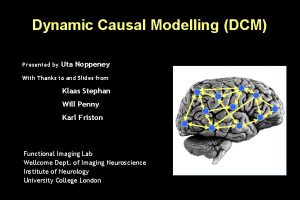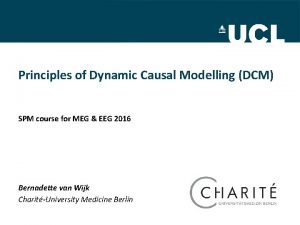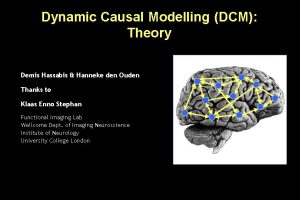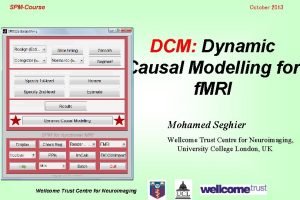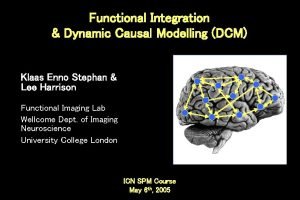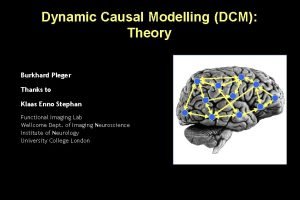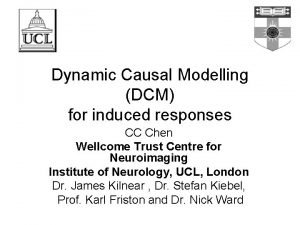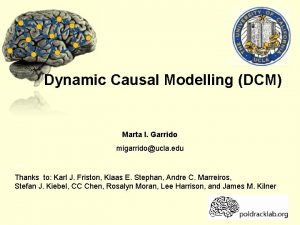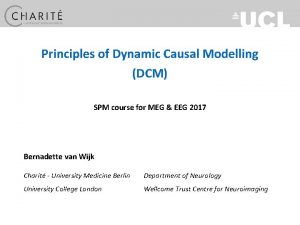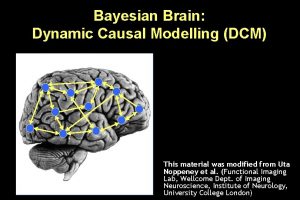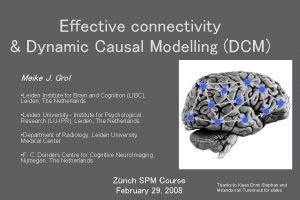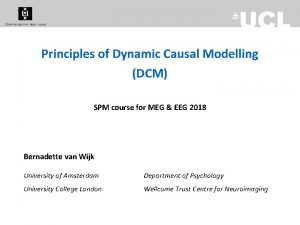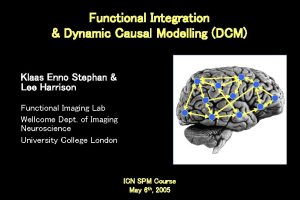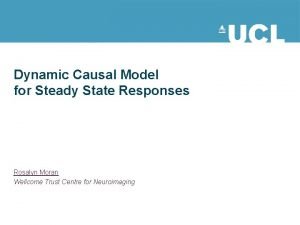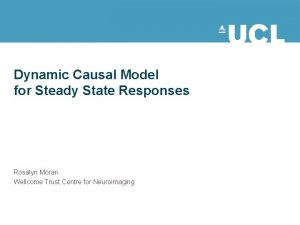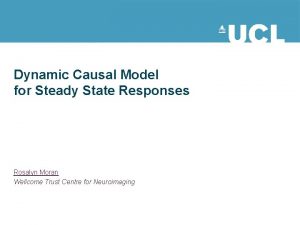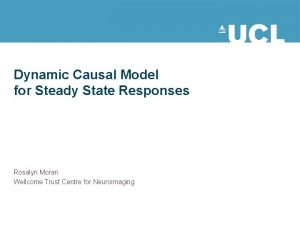Dynamic Causal Modelling DCM for f MRI Rosalyn



















































- Slides: 51

Dynamic Causal Modelling (DCM) for f. MRI Rosalyn Moran Virginia Tech Carilion Research Institute With thanks to the FIL Methods Group for slides and images SPM Course, UCL May 2013

Dynamic causal modelling (DCM) • DCM framework was introduced in 2003 for f. MRI by Karl Friston, Lee Harrison and Will Penny (Neuro. Image 19: 1273 -1302) • part of the SPM software package • currently more than 250 160 published papers on DCM

Overview • Dynamic causal models (DCMs) – Basic idea – Neural level – Hemodynamic level – Parameter estimation, priors & inference • Applications of DCM to f. MRI data - Attention to Motion - The Status Quo Bias

Overview • Dynamic causal models (DCMs) – Basic idea – Neural level – Hemodynamic level – Parameter estimation, priors & inference • Applications of DCM to f. MRI data - Attention to Motion - The Status Quo Bias



Functional vs Effective Connectivity Functional connectivity is defined in terms of statistical dependencies, it is an operational concept that underlies the detection of (inference about) a functional connection, without any commitment to how that connection was caused - Assessing mutual information & testing for significant departures from zero - Simple assessment: patterns of correlations - Undirected or Directed Functional Connectivity eg. Granger Connectivity Effective connectivity is defined at the level of hidden neuronal states generating measurements. Effective connectivity is always directed and rests on an explicit (parameterised) model of causal influences — usually expressed in terms of difference (discrete time) or differential (continuous time) equations. - Eg. DCM - causality is inherent in the form of the model ie. fluctuations in hidden neuronal states cause changes in others: for example, changes in postsynaptic potentials in one area are caused by inputs from other areas.

Dynamic Causal Modeling (DCM) Hemodynamic forward model: neural activity BOLD Electromagnetic forward model: neural activity EEG MEG LFP Neural state equation: f. MRI EEG/MEG simple neuronal model complicated forward model complicated neuronal model simple forward model inputs

Deterministic DCM y y H{2} x 2 H{1} A(2, 2) A(2, 1) C(1) u 1 A(1, 2) x 1 B(1, 2) A(1, 1) u 2

Overview • Dynamic causal models (DCMs) – Basic idea – Neural level – Hemodynamic level – Parameter estimation, priors & inference • Applications of DCM to f. MRI data - Attention to Motion - The Status Quo Bias

Example: a linear model of interacting visual regions x 3 FG left FG right x 1 LG left LG right RVF u 2 x 4 x 2 LVF u 1 Visual input in the - left (LVF) - right (RVF) visual field. LG = lingual gyrus FG = fusiform gyrus

Example: a linear model of interacting visual regions x 3 x 1 RVF u 2 FG left LG left FG right LG right x 4 LG = lingual gyrus FG = fusiform gyrus x 2 Visual input in the - left (LVF) - right (RVF) visual field. LVF u 1

Example: a linear model of interacting visual regions x 3 x 1 FG left LG left RVF u 2 state changes FG right LG right x 4 LG = lingual gyrus FG = fusiform gyrus x 2 Visual input in the - left (LVF) - right (RVF) visual field. LVF u 1 effective connectivity system state input parameters external inputs

Extension: bilinear model x 3 FG left FG right x 4 x 1 LG left LG right x 2 RVF u 2 CONTEXT u 3 LVF u 1

Vanilla DCM: Deterministic Bilinear DCM driving input Simply a two-dimensional taylor expansion (around x 0=0, u 0=0): modulation Bilinear state equation:


Example: context-dependent decay stimuli u 1 context u 2 u 1 - + - x 1 + + u 1 u 2 Z 1 + x 2 - x Z 2 1 - Penny et al. 2004, Neuro. Image x 2

bilinear DCM non-linear DCM modulation driving input modulation Two-dimensional Taylor series (around x 0=0, u 0=0): Bilinear state equation: Nonlinear state equation:

Neural population activity u 2 u 1 x 3 x 1 x 2 f. MRI signal change (%) Nonlinear dynamic causal model (DCM) Stephan et al. 2008, Neuro. Image

y y BOLD y activity x 2(t) neuronal states hemodynamic model x integration modulatory input u 2(t) t Neural state equation endogenous connectivity t λ activity x 3(t) activity x 1(t) driving input u 1(t) y modulation of connectivity direct inputs

Overview • Dynamic causal models (DCMs) – Basic idea – Neural level – Hemodynamic level – Parameter estimation, priors & inference • Applications of DCM to f. MRI data - Attention to Motion - The Status Quo Bias

Basics of DCM: Neuronal and BOLD level y • Cognitive system is modelled at its underlying neuronal level (not directly accessible for f. MRI). • The modelled neuronal dynamics (x) are transformed into area-specific BOLD signals (y) by a hemodynamic model (λ). λ • Overcoming Regional variability of the haemodynamic response • x ie DCM not based on temporal precedence at the measurement level

Basics of DCM: Neuronal and BOLD level y λ x “Connectivity analysis applied directly on f. MRI signals failed because hemodynamics varied between regions, rendering termporal precedence irrelevant” …. The neural driver was identified using DCM, where these effects are accounted for…

The hemodynamic model • u 6 hemodynamic parameters: stimulus functions t neural state equation important for model fitting, but of no interest for statistical inference • hemodynamic state equations Computed separately for each area region-specific HRFs! Friston et al. 2000, Neuro. Image Stephan et al. 2007, Neuro. Image Estimated BOLD response

The hemodynamic model • u 6 hemodynamic parameters: stimulus functions t neural state equation important for model fitting, but of no interest for statistical inference • hemodynamic state equations Computed separately for each area region-specific HRFs! Friston et al. 2000, Neuro. Image Stephan et al. 2007, Neuro. Image Estimated BOLD response

How interdependent are neural and hemodynamic parameter estimates? A B C h ε Stephan et al. 2007, Neuro. Image

Overview • Dynamic causal models (DCMs) – Basic idea – Neural level – Hemodynamic level – Parameter estimation, priors & inference • Applications of DCM to f. MRI data - Attention to Motion - The Status Quo Bias

DCM is a Bayesian approach new data posterior prior knowledge likelihood ∙ prior Bayes theorem allows one to formally incorporate prior knowledge into computing statistical probabilities. In DCM: empirical, principled & shrinkage priors. The “posterior” probability of the parameters given the data is an optimal combination of prior knowledge and new data, weighted by their relative precision.

Overview: parameter estimation • Combining the neural and hemodynamic states gives the complete forward model. • An observation model includes measurement error e and confounds X (e. g. drift). • Bayesian inversion: parameter estimation by means of variational EM under Laplace approximation • Result: Gaussian a posteriori parameter distributions, characterised by mean ηθ|y and covariance Cθ|y. stimulus function u neural state equation parameters hidden states state equation ηθ|y modelled BOLD response observation model

VB in a nutshell (mean-field approximation) Neg. free-energy approx. to model evidence. Mean field approx. Maximise neg. free energy wrt. q = minimise divergence, by maximising variational energies Iterative updating of sufficient statistics of approx. posteriors by gradient ascent.

Bayesian Inversion Specify generative forward model (with prior distributions of parameters) Regional responses Variational Expectation-Maximization algorithm Iterative procedure: 1. 2. 3. Compute model response using current set of parameters Compare model response with data Improve parameters, if possible 1. Posterior distributions of parameters 2. Model evidence

Inference about DCM parameters: Bayesian single-subject analysis • Gaussian assumptions about the posterior distributions of the parameters • posterior probability that a certain parameter (or contrast of parameters) is above a chosen threshold γ: • By default, γ is chosen as zero – the prior ("does the effect exist? ").

Inference about DCM parameters: Bayesian parameter averaging (FFX group analysis) Likelihood distributions from different subjects are independent group posterior covariance group posterior mean Under Gaussian assumptions this is easy to compute: individual posterior covariances and means

Inference about DCM parameters: RFX group analysis (frequentist) • In analogy to “random effects” analyses in SPM, 2 nd level analyses can be applied to DCM parameters: Separate fitting of identical models for each subject Selection of parameters of interest one-sample t-test: parameter > 0 ? paired t-test: parameter 1 > parameter 2 ? rm. ANOVA: e. g. in case of multiple sessions per subject

Inference about Model Architecture, Bayesian Model Selection Model evidence: Approximation: Free Energy accounts for both accuracy and complexity of the model allows for inference about structure (generalisability) of the model Fixed Effects Model selection via Random Effects Model selection log Group Bayes factor: via Model probability:

Overview • Dynamic causal models (DCMs) – Basic idea – Neural level – Hemodynamic level – Parameter estimation, priors & inference • Applications of DCM to f. MRI data - Attention to Motion - The Status Quo Bias

Bayesian Model Selection DCM – Attention to Motion Results Paradigm 4 conditions - fixation only - observe static dots - observe moving dots - attend to moving dots baseline SPC + photic V 3 A + motion V 5+ Attention – No attention Büchel & Friston 1997, Cereb. Cortex Büchel et al. 1998, Brain What connection in the network mediates attention ?

Bayesian Model Selection m 1 m 2 Modulation By attention PPC External stim V 1 m 3 V 5 m 4 Modulation By attention PPC stim V 1 V 5 0. 10 PPC 0. 39 0. 26 1. 25 stim 0. 26 V 1 0. 13 0. 46 [Stephan et al. , Neuroimage, 2008] stim V 1 V 5 estimated effective synaptic strengths for best model (m 4) attention models marginal likelihood PPC V 5

Parameter Inference attention MAP = 1. 25 0. 10 PPC 0. 26 0. 39 1. 25 stim 0. 26 V 1 0. 13 0. 46 0. 50 motion Stephan et al. 2008, Neuro. Image V 5

Data Fits motion & attention static motion & no attention dots V 1 V 5 PPC observed fitted

Overview • Dynamic causal models (DCMs) – Basic idea – Neural level – Hemodynamic level – Parameter estimation, priors & inference • Applications of DCM to f. MRI data - Attention to Motion - The Status Quo Bias

Overcoming status quo bias in the human brain Fleming et al PNAS 2010 Difficulty Low High Decision Accept Reject

Overcoming status quo bias in the human brain Fleming et al PNAS 2010 Difficulty Low High Decision Accept Reject Main effect of difficulty in medial frontal and right inferior frontal cortex

Overcoming status quo bias in the human brain Fleming et al PNAS 2010 Difficulty Low High Decision Accept Reject Interaction of decision and difficulty in region of subthalamic nucleus: Greater activity in STN when default is rejected in difficult trials

Overcoming status quo bias in the human brain Fleming et al PNAS 2010 DCM: “aim was to establish a possible mechanistic explanation for the interaction effect seen in the STN. Whether rejecting the default option is reflected in a modulation of connection strength from r. IFC to STN, from MFC to STN, or both “… MFC r. IFC STN

Overcoming status quo bias in the human brain Fleming et al PNAS 2010 Difficulty MFC r. IFC Reject STN STN Difficulty MFC STN Reject r. IFC Reject STN Difficulty r. IFC Reject STN Reject Difficulty MFC r. IFC STN Difficulty MFC r. IFC Reject STN Reject

Example: Overcoming status quo bias in the human brain Fleming et al PNAS 2010 Difficulty MFC r. IFC Reject STN Difficulty STN Reject r. IFC Reject STN Difficulty r. IFC Reject STN Reject Difficulty MFC r. IFC STN Difficulty MFC r. IFC Reject STN Reject

Overcoming status quo bias in the human brain Fleming et al PNAS 2010 The summary statistic approach Effects across subjects consistently greater than zero P < 0. 01 * P < 0. 001 **

The evolution of DCM in SPM • DCM is not one specific model, but a framework for Bayesian inversion of dynamic system models • The default implementation in SPM is evolving over time – better numerical routines for inversion – change in priors to cover new variants (e. g. , stochastic DCMs, endogenous DCMs etc. ) To enable replication of your results, you should ideally state which SPM version you are using when publishing papers.

GLM vs. DCM tries to model the same phenomena (i. e. local BOLD responses) as a GLM, just in a different way (via connectivity and its modulation). No activation detected by a GLM → no motivation to include this region in a deterministic DCM. However, a stochastic DCM could be applied despite the absence of a local activation. Stephan 2004, J. Anat.

Thank you
 Rosalyn la liberte
Rosalyn la liberte Marcela boni evangelista
Marcela boni evangelista Tim willet
Tim willet Rosalyn ashby
Rosalyn ashby Rosalyn moran
Rosalyn moran Rosalyn moran
Rosalyn moran Rosalyn scaff
Rosalyn scaff Dcm300
Dcm300 Dementia care mapping checklist
Dementia care mapping checklist K h d m d c m
K h d m d c m Metric mania conversion challenge answer key
Metric mania conversion challenge answer key 11ax dcm
11ax dcm Kg hg dam m dm cm mm
Kg hg dam m dm cm mm Megger dcm 305e
Megger dcm 305e Dcm spm
Dcm spm Dcm
Dcm 1970 dçm
1970 dçm Conversion table for measurements
Conversion table for measurements Hkhidvnukcm -site:youtube.com
Hkhidvnukcm -site:youtube.com Dcm-2301
Dcm-2301 Dcm
Dcm Khd_dcm
Khd_dcm The iso/iec 27001 standard — dcm services
The iso/iec 27001 standard — dcm services Dynamic dynamic - bloom
Dynamic dynamic - bloom Humanitr
Humanitr Datorkunskap för nybörjare
Datorkunskap för nybörjare Vad kallas den mantel som bars av kvinnor i antikens rom
Vad kallas den mantel som bars av kvinnor i antikens rom Fspos vägledning för kontinuitetshantering
Fspos vägledning för kontinuitetshantering Rita perspektiv
Rita perspektiv Ministerstyre för och nackdelar
Ministerstyre för och nackdelar Claes martinsson
Claes martinsson Sju principer för tillitsbaserad styrning
Sju principer för tillitsbaserad styrning Exempel på dikter
Exempel på dikter Nyckelkompetenser för livslångt lärande
Nyckelkompetenser för livslångt lärande Tidbok
Tidbok Gibbs reflekterande cykel
Gibbs reflekterande cykel Varför kallas perioden 1918-1939 för mellankrigstiden?
Varför kallas perioden 1918-1939 för mellankrigstiden? Orubbliga rättigheter
Orubbliga rättigheter Stål för stötfångarsystem
Stål för stötfångarsystem Big brother rösta
Big brother rösta Verktyg för automatisering av utbetalningar
Verktyg för automatisering av utbetalningar Vad är hsil
Vad är hsil Jag har gått inunder stjärnor text
Jag har gått inunder stjärnor text Vem räknas som jude
Vem räknas som jude Sju för caesar
Sju för caesar Boverket ka
Boverket ka Strategi för svensk viltförvaltning
Strategi för svensk viltförvaltning Novell typiska drag
Novell typiska drag Vad är verksamhetsanalys
Vad är verksamhetsanalys Tack för att ni har lyssnat
Tack för att ni har lyssnat Vishnuiter
Vishnuiter Centrum för kunskap och säkerhet
Centrum för kunskap och säkerhet


